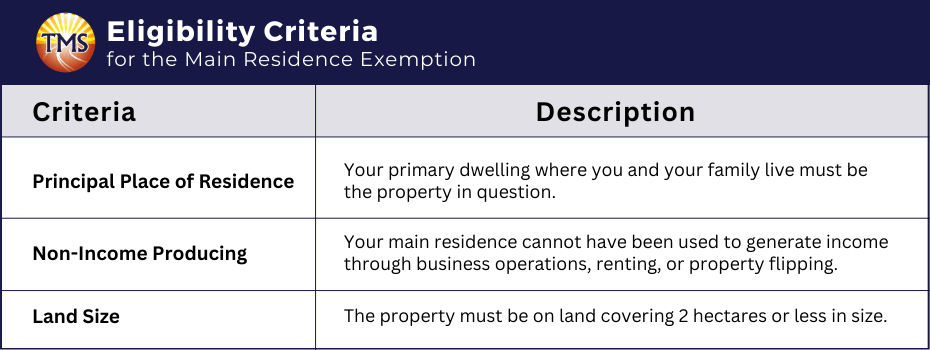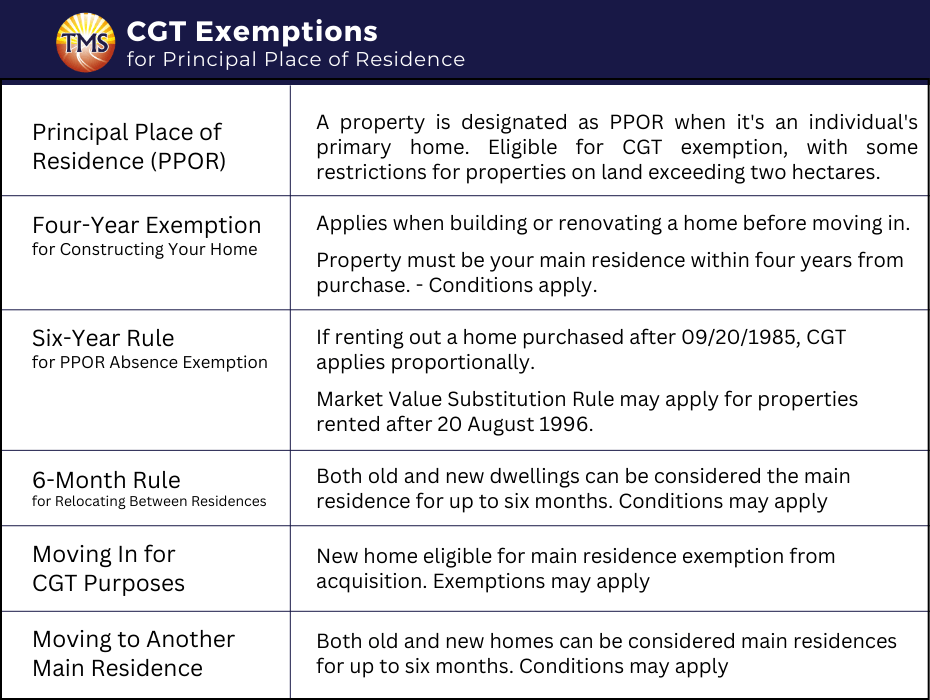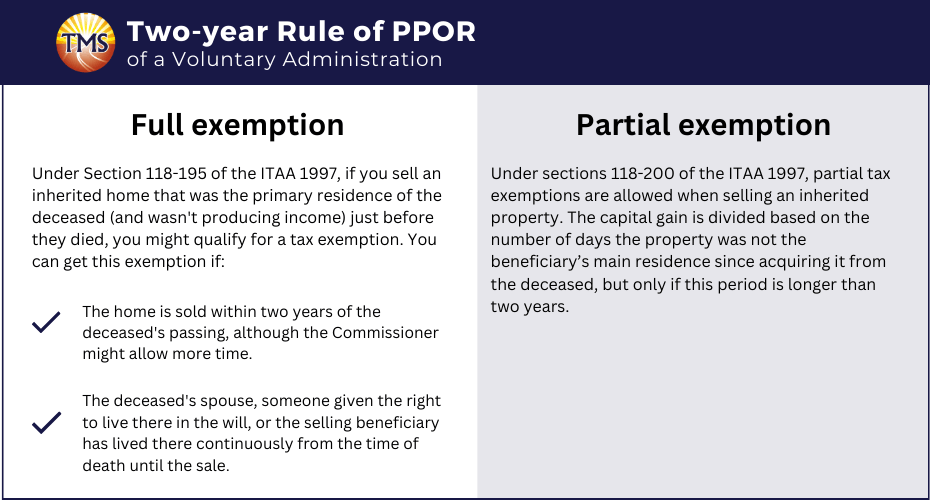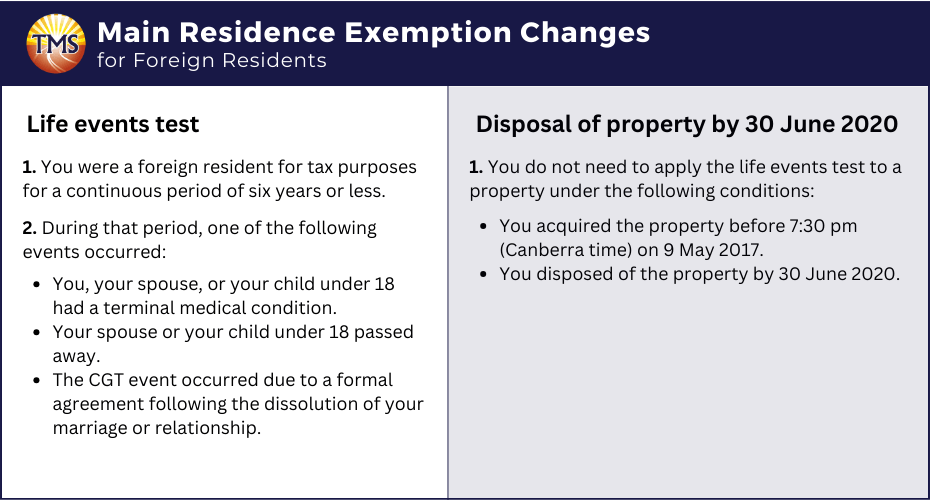Understanding the tax implications of your Principal Place of Residence in Australia

.
Your Principal Place of Residence (PPOR) is the main place where you live. This could be a house, flat, home unit, or even unconventional spaces like a caravan or houseboat. Recognising your PPOR is crucial for tax purposes. It influences eligibility for tax exemptions such as the main residence exemption, impacting your Capital Gains Tax (CGT).
Key factors determining if a dwelling qualifies as your PPOR include the duration of your stay and your intention to make it your home. To qualify for exemptions, you must live there continuously. If you own land with a dwelling that is your PPOR, you might not have to pay land tax on it. You can be away from your PPOR for up to six years and still claim it as your main residence for tax reasons.
Earning rental income from a part of your PPOR, or situations like an extended holiday or buying a new residence, can affect your eligibility for these exemptions. It’s important to understand these details about PPOR and related tax exemptions. They ensure you are informed about your tax responsibilities and rights. For more insights on how PPOR affects your taxes and possible exemptions, keep reading our article.
Main residence exemption for Capital Gains Tax in Australia
To be eligible for the main residence exemption from Capital Gains Tax (CGT) in Australia, your primary home must satisfy specific criteria:
Principal Place of Residence
The property in question must be your main residence, where you, your partner, and any dependents reside. It should be the place where you primarily live.
Non-income producing
Your main residence should not be used for generating income. This means no business operations, rental activities, or property flipping (buying, renovating, and selling for profit) should occur there.
Land size
The property must be located on a land area of two hectares or less.
Meeting these conditions typically means you’re not liable for Capital Gains Tax (CGT) when selling your home, and any capital loss is disregarded.
If your situation doesn’t meet all these criteria, you might still qualify for a partial exemption. The proportion of the exemption can be calculated using the Capital Gains Tax (CGT) property exemption tool from the Australian Taxation Office (ATO).
Understanding the definition of a dwelling for CGT purposes
In the context of Capital Gains Tax (CGT) exemptions on residential properties in Australia, it’s essential to define what a “dwelling” is. A dwelling is any property designed and used mainly for residential accommodation. This includes various types of living spaces, such as:
-
Traditional houses or cottages, typically for single-family living.
-
Modern apartments or flats, commonly in multi-unit buildings.
-
Strata title units, usually in condominium complexes.
-
Units in retirement villages.
-
Unique residential accommodations like caravans, houseboats, or other mobile homes.
It’s important to remember that a flat or home unit can include physically separate areas like a laundry room, storeroom, or garage. These areas are subject to the same CGT exemption as the main residential unit. However, if you sell these separate structures independently (e.g., selling a garage separately), they won’t be eligible for the CGT exemption unless compulsorily acquired.
For tax purposes, if a dwelling is your Principal Place of Residence, you may qualify for the main residence exemption from CGT. This exemption also applies to partial principal places under specific conditions. If you generate rental income from part of the dwelling or own other land, this might affect the CGT exemptions. It’s important for Australian residents, especially those who might be considering selling their property or have experienced life events affecting their residency, to understand these nuances to navigate their tax obligations effectively.
Identifying your main residence
A dwelling is generally considered your main residence if it meets the following criteria:
-
It’s where you and your family live.
-
It houses your personal belongings.
-
It’s the address for your mail delivery.
-
It’s the address listed on the electoral roll.
-
Essential services like gas and electricity are connected.
Additionally, the length of time you stay in the dwelling and your intention to use it as your home are important considerations. To qualify as your main residence, the property must include a dwelling, and you must have resided there. Note that exemptions do not apply to vacant land without a dwelling.
CGT exemptions for Principal Place of Residence (PPOR)
A property qualifies as a Principal Place of Residence (PPOR) when an individual lives, occupies, and uses it as their main home. When a property is recognised as the owner’s PPOR, it’s eligible for an exemption from Capital Gains Tax (CGT). However, this exemption comes with certain limitations, particularly for properties located on land that is more than two hectares in size.
Four-year exemption for constructing or renovating your main residence
This exemption is particularly relevant if you’re building a new home or buying an existing one to renovate before moving in. The Australian Taxation Office (ATO) allows such a property to be considered your main residence for Capital Gains Tax (CGT) purposes, exempting it from CGT, provided you move into the property within four years of the original purchase date.
For instance, if you purchase land and build a house to live in, you have up to four years to complete the construction and designate it as your primary residence. This can help you avoid CGT when you sell the property.
To qualify for this exemption, you must meet certain criteria:
-
The renovated or newly constructed home must become your primary residence as soon as reasonably possible after completion.
-
The property must remain your primary residence for at least three months.
-
During the four-year period, no other property can be your primary residence for CGT purposes. However, a six-month overlap is allowed, where both properties can be considered your primary residence. This overlap period offers potential tax planning advantages.
Six-year rule for absence exemption on Principal Place of Residence (PPOR)
When it comes to renting out your main home, acquired after 20 September 1985, you need to be mindful of potential Capital Gains Tax (CGT) implications. Properties bought before this date are exempt from CGT, even if rented out.
For properties that became your primary residence and were rented out for the first time before 7:30 pm on 20 August 1996, after being purchased post 20 September 1985, CGT is calculated proportionally. For instance, if you’ve owned the property for up to six years and rented it for two years, a third of the total capital gain is subject to CGT.
In contrast, if your main home was rented out for the first time after 7:30 pm on 20 August 1996, having been purchased post 20 September 1985, the Market Value Substitution Rule (MVSR) is applied. Under this rule, the property’s Fair Market Value at the start of its rental period is used for CGT purposes. CGT is then calculated based on any increase in value from that valuation date. Remember, the 50% CGT discount is only applicable after owning the property for more than one year and one day from the contract date.
The 6-month rule for transitioning between Principal Places of Residence (PPOR)
The 6-month rule states that when you acquire a new dwelling intending to make it your Principal Place of Residence, while still owning your current main residence, both properties can be treated as your main residence for a maximum of six months. This rule applies specifically to taxpayers in such transitional situations.
Establishing a new home for Capital Gains Tax (CGT) purposes
For CGT, your new home qualifies for the main residence exemption from the time you acquire it, on the condition that you move in as soon as practically possible. When you buy a new home, the ‘time you acquire it’ typically means the settlement date of the purchase contract.
However, there are some exceptions:
-
If moving in is delayed due to illness or unexpected events, the property remains eligible for the exemption, provided you move in promptly once the issue causing the delay is resolved, such as recovering from an illness.
-
If the property is being rented to someone else and you can’t move in immediately, it doesn’t become your main residence for CGT purposes until you actually reside there.
-
If your old home hasn’t been sold yet, you can consider both your old and new homes as your main residence for up to six months.
It’s crucial to be aware that CGT’s six-month rule might differ from certain State Stamp Duty Concessions, like those in Queensland.
Transitioning to a new main residence
When you purchase a new home before selling your old one, both properties can be treated as your main residence for a period of up to six months, provided certain conditions are met:
-
You must have lived in your old home as your main residence continuously for at least three months in the 12 months before selling it.
-
During the 12-month period, if there was any time the old home was not your main residence, it must not have been used to produce income (like renting it out).
-
The new property must become your main residence.
For additional information about transitioning to another main residence and eligibility for the main residence exemption, refer to the guidance provided by the Australian Taxation Office (ATO).
Two-year rule for Principal Place of Residence inheritance exemption
When you inherit a property that was the primary residence of your late parents, it’s important to understand the capital gains implications associated with this inheritance. In the case of a family home being passed down as part of an estate, there is a critical two-year period to consider.
If you decide to sell the property before reaching the two-year mark, you need to be aware of the potential Capital Gains Tax (CGT) implications. Selling within this period may result in a CGT event, depending on various factors including whether the property was used to generate income.
On the other hand, if the property is not sold within two years, you should understand how CGT will be apportioned thereafter. The CGT implications can vary based on how the property is used during the period of ownership and other individual circumstances. It’s crucial that you seek advice from a tax professional, to understand how these rules apply to your situation.
Full exemption for inherited dwelling
A full exemption from Capital Gains Tax (CGT) can apply when selling an inherited property that was the main residence of the deceased just before their passing and was not being used to generate income at that time.
This exemption is available under either of the following circumstances:
-
The property is sold within two years from the date of the deceased’s death. Note the Commissioner of Taxation may extend this period under certain circumstances.
-
The property has been continuously used as the main residence from the date of death until its sale by either the deceased’s spouse, a person who had the right to live in the property as per the deceased’s will, or the individual beneficiary who is selling the property.
Partial exemption for inherited property
In cases where a full exemption does not apply, a partial exemption might be relevant. This involves calculating the capital gain based on the number of days the property was not the main residence of the beneficiary since inheriting it from the deceased, provided this period exceeds two years. The CGT liability is then apportioned accordingly for the period the property was not used as the main residence.
Main residence exemption changes for foreign residents
As a foreign resident, you need to be aware of the changes to the main residence exemption from Capital Gains Tax (CGT) for property sales. For sales occurring after 30 June 2020, foreign residents are typically not eligible for the main residence exemption, unless they satisfy the criteria of the life events test.
If the life events test criteria are not met, foreign residents cannot claim the main residence exemption. This holds true even if you were an Australian resident for part of the time you owned the property.
However, if you sold your property before 30 June 2020, you may still be eligible for the main residence exemption as a foreign resident. It’s important to note these rules do not apply if you are an Australian resident at the time of selling your property.
Life events test for main residence exemption
To qualify for the life events test in the context of disposing of your residential property as a foreign resident, you must fulfill both of the following conditions:
-
Continuous foreign residency period: You were a foreign resident for tax purposes for a continuous period of six years or less.
-
Occurrence of specific life events: During this period, one of these significant life events must have occurred:
-
Either you, your spouse, or your child under 18 suffered from a terminal medical condition.
-
Your spouse or your child under 18 passed away.
-
The Capital Gains Tax (CGT) event was a result of a formal agreement related to the dissolution of your marriage or de facto relationship.
-
If you meet both these criteria and adhere to the general requirements for the exemption, you are eligible to:
-
Claim the main residence exemption from CGT.
-
Use this exemption to modify the capital gains withholding typically applicable to foreign residents when selling property in Australia.
Exemption criteria for disposal of property by 30 June 2020
The life events test doesn’t need to be applied to your property under these specific conditions:
-
Property acquisition date: if you acquired the property before 7:30 pm (Canberra time) on 9 May 2017.
-
Disposal date: if you disposed of the property by 30 June 2020.
If you fulfill both these conditions, along with the general requirements for the exemption, you’re eligible to claim the main residence exemption from Capital Gains Tax (CGT).
However, if you were not an Australian tax resident while residing in your property, it’s unlikely you will meet the criteria for the CGT main residence exemption. For disposals made under a contract, the critical time for disposal is when the contract is entered into. In cases where there’s no contract, the disposal time is considered to be when the property settlement takes place.
Implications for your deceased estate as a foreign resident
If you’re classified as a foreign resident for tax purposes at the time of your death, the rules regarding property and Capital Gains Tax (CGT) also extend to:
-
Legal personal representatives, trustees, and beneficiaries of your deceased estate.
-
Surviving joint tenants of any property you owned.
-
Special disability trusts that may be involved with your estate.
These individuals or entities will be subject to the same CGT rules and exemptions that would have applied to you as a foreign resident in relation to your property assets.
Next step is to contact TMS Financials
TMS Financials provides you with a team of experienced professionals that help you achieve your financial goals through smart tax structures and strategic financial structuring. We’re a one-stop shop for all financial needs and pride ourselves on building strong partnerships with our clients.
Book a free financial health review to see the difference we can make in your financial future.
Disclaimer
Related Articles

Minimising Capital Gains Tax on investment property guide
Minimising Capital Gains Tax on investment...

Division 7A compliance: Essential updates for business owners in 2025
Division 7A compliance: Essential updates for...

How to save FBT costs with your next Electric Vehicle
How to save FBT costs with your next Electric...
Contact Us
Tax Insights & Business Advice
Receive only the guidance that matters. Subscribe now for personalised tips and expert advice, directly suited for you and your business.





